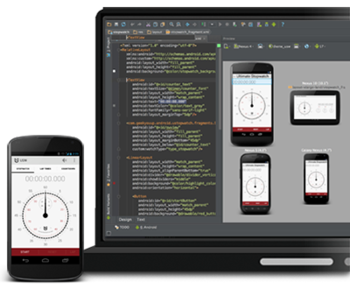Google has introduced an integrated developer environment (IDE) aimed at easing development of Android apps.
Android Studio made its debut Wednesday at the Google I/O conference in San Francisco.
Android developers could use the Android Development Tools (ADT) plug-in for the Eclipse IDE, but Android Studio will be the first dedicated IDE for the mobile OS. Google built Android Studio on the base of IntelliJ's Idea Java IDE.
"The pivot around the IntelliJ IDE is a shift for Google," noted Al Hilwa, who covers application development software for IDC, in an email interview. IntelliJ "is less complex and more friendly than Eclipse and should help Android reach a broader section of developers," Hilwa wrote.
Apple invested a lot of effort into its Xcode IDE in order to make it easy for developers to write apps for the iOS iPhone and iPad that compete with Android. Android Studio levels the playing field, in that it can help "hobbyists who are not hard skilled in the traditional Java toolset," Hilwa wrote.
Android Studio will have a number of features specifically designed to help build Android applications. It comes with templates to build apps with a standard Android look and feel. It can refactor to code to run more efficiently. It includes Lint, a set of tools to catch version compatibility issues and other potential bugs. And it includes ProGuard, which obfuscates code to hinder reverse engineering.
The software also works with the Gradle automated build system. Development shops can use Gradle to automate their process of building, testing, publishing and deploying Android apps, as well as to synchronize these activities with software lifecycle management tools such as Maven or Ivy.
Google warned potential users that work on Android Studio has not been completed -- this is version 0.1 of the IDE -- and several features have not been completed, or remain buggy.

Google's Android Studio
At the conference, Google also demonstrated the fruits of a new single sign-on authentication technology, called the Cross-Platform Single Sign-On. This set of APIs (application programming interfaces) can minimize the amount of times a user will have to sign into services, by allowing the device to share log-in credentials among trusted services using the OAuth 2 protocol. It is a core component of Google+ and Google Wallet, both of which were showcased at the conference.
"Not having to sign in repeatedly feels so natural for users that they don't even notice it. But as more and more apps deploy this sort of magic, you don't want to be the hold-out that's pestering users for passwords on Web sites or, worse, on tiny mobile-device keyboards," wrote Tim Bray, an engineer on the Google identity team, in a blog post announcing the API.


